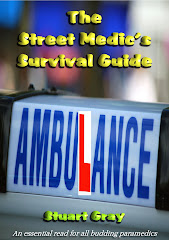Five emergency calls; all taken by ambulance, four of them on blue lights.
A proper working shift this one. Almost all of the calls were genuine ambulance emergencies, deserving of ‘category A’ status.
First off, a 72 year-old woman with chest pain, headache and a high BP (which was taken by a family member). She had a normal BP when I checked it but there seemed to be an element of paranoia because she wanted it checked every few minutes and worried about it. This is the problem with home diagnostics; people begin to believe they have problems when they have no idea what the numbers mean.
Although she had normal vital signs, she insisted she was very ill and so did her family. Her past medical history prompted the crew to take her to hospital.
A strange call to a 20 year-old man who was found unconscious in a doorway. I was expecting a drunken person that I’d be able to shake awake with no problems but when I arrived two MOPs were hovering over him with worried expressions. The guy had his trousers and underwear halfway down his legs and he was face-down – completely unresponsive. This seemed bizarre; there was no explanation for his indecent exposure at this time of day.
When the crew arrived I had got started with obs and when we moved him we discovered a porn magazine underneath him, although I really don’t know if there was a connection. After a short time we managed to get him to open his eyes but he wasn’t talking to us and stared ahead with a totally drugged-up look. I asked him about this and he denied it. He looked unstable to me – physically and mentally.
His ECG was abnormal and appeared to show hypertrophy and ST elevation, so I asked him (when I could wake him) if he had chest pain. He nodded and went straight back into a deep slumber.
We ‘blued’ him in and he woke up a little more in Resus. He became unco-operative and attempted to leave the bed several times. ‘Why are you doing this to me?’ he asked over and over again. Then he grinned and fell back onto the bed unconscious.
I still don’t know why he was lying in the doorway like that and why his choice of reading matter lay beneath him. I suppose he settled down there after taking something (like LSD) and the magazine was company for him.
A 49 year-old woman with DIB and ‘purple lips’ was hyperventilating and didn’t have purple lips at all. The crew were on scene after I’d travelled a long way to get there, so I turned around and went back to my own area, only to be called again to the same location, more or less.
A 30 year-old had fitted and was now ‘passed out’ according to the caller, so I contacted Control and asked if I was required. After all, epileptics pass out a lot after a seizure, so it wouldn’t necessarily be life-threatening unless he fitted several times, continually or didn’t recover consciousness. I was sure a nearer crew could deal with it but I was sent anyway.
On the way, I received a message that a crew was on scene. I thought a cancellation would come through but it didn’t and I continued. When I arrived the crew was working over a patient lying on the ground. A lot of people had gathered round and I knew from the behaviour of the crew that this wasn’t a sleeping epileptic at all – it was a cardiac arrest in the street.
The young man had been jogging and suddenly collapsed. His agonal movements had been misinterpreted as fitting and when he stopped he was simply put in the recovery position. He wasn’t breathing but nobody noticed.
I assisted the crew with CPR and began my drugs protocols. He was shocked several times by the defibrillator and this brought a few gasps from the watching MOPs. In fact, they were getting too close and we had to tell them to back off several times before the police arrived to clear the area. Traffic was slowing as cars tail-gated for a look at what was going on; it was becoming a circus.
Everything was going smoothly and the patient’s condition remained the same – VF. I asked a bystander to help with the IV fluids and he became my drip stand. I asked his name but he was so nervous that he couldn’t remember it at first.
We moved the patient into the ambulance when the second FRU showed up (I had called this in as soon as I saw what was going on and requested a second crew). I gathered the rest of my stuff and followed them into the vehicle, where I found a complete stranger giving instructions.
‘Who are you?’ I asked.
‘I’m a cardiologist’, he replied.
‘Have you got ID?’
‘Yes’. He flashed a valid NHS ID card and I said he could stay and help but during the trip to hospital I had to remind him over and over again that I was in charge of the patient. He barked orders and got generally excited about the change in the patient’s condition when, after yet another shock, he converted from VF to VT. This was encouraging but by no means absolute and sure enough, by the time we reached hospital, he was back in VF.
I’m not knocking the doctor of course but the crew and me were perfectly able to deal with the patient; we all know what to do and everyone was working in harmony. His behaviour, however well-intended, could have thrown everyone into confusion at the risk of the patient and that just wasn’t going to happen. Having said that, it was valuable to have someone with his expertise on board because it was a difficult intubation and he helped with good cricoid pressure when I needed it.
At hospital, the patient’s condition changed from VT to VF several times until they finally stabilised him and he was taken to ITU. My colleagues have been kind enough to keep me up to date with his progress and I’m told that he is still critical but had opened his eyes after almost a week.
After the handover of this patient I went to the loo (as you do) and as I wandered back from the toilet to Resus via the Major's ward I noticed a patient sitting up in bed in a cubicle. Something caught my eye and I was sure of what it was but I hovered to watch him as he guiltily hid his hand. Then I saw it…smoke. The guy had an oxygen mask on and had slipped it up to his forehead while he enjoyed a cigarette in hospital! None of the nurses even noticed until I drew their attention to it. He could have set himself and the ward alight with his stupidity.
My last call was a distance away again. This time a 39 year-old woman who’d been learning to roller blade with her husband had fallen badly and broken her arm. Both bones were shattered below her elbow and she was in agony. I gave her entonox until the crew arrived, then I supplemented that with morphine, which eased the pain a little. This was an awkward job because her arm was badly deformed and the slightest movement caused her great pain and put the limb at risk. She had a good distal pulse, so as long as we were careful her arm would survive this.
A good shift for me; 'proper' jobs and I was in and out of my bag more than usual for a single day. I went home thinking I’d helped to make a difference – especially for the young man who’d suspended in the street. He wasn’t identified for a few days afterwards, I understand. Oh and my semi-willing drip-stand, who I’d never had the chance to thank properly was called Owen. Thanks Owen!
Be safe.
Subscribe to:
Post Comments (Atom)















5 comments:
I've had exactly the same case as your 49 yof with DIB and Cyanosis of the lips,(turned out to be a panic attack). In my inability to figure out what was going on I called for an ambulance. 30 minutes later the crew turned up and my 'patient' had completely recovered; the look the crew gave me, the shame of it all...
Yet another busy and varied day in the life of front line NHS staff!
Gripping reading, as always.
Why is it you do not put a screen around yourselves and a patient such as the one with the cardiac arrest so that this “circus” cannot stand around watching what is going on? I know it can be done because when a woman in a nearby town to where I live had part of her leg come off in an accident, they put a screen around her. I did not see this; the photo of the scene as it was happening was shown in one of the local papers.
I would not want a “circus” around me and find it disturbing that those people were able to watch while the shock treatment was going on.
Why is it you do not put a screen around yourselves and a patient such as the one with the cardiac arrest so that this “circus” cannot stand around watching what is going on? I know it can be done because when a woman in a nearby town to where I live had part of her leg come off in an accident, they put a screen around her. I did not see this; the photo of the scene as it was happening was shown in one of the local papers.
I would not want a “circus” around me and find it disturbing that those people were able to watch while the shock treatment was going on.
Previous Question: Why is it you do not put a screen around yourselves and a patient ...
I guess you just don't have an answer to this question, do you?
Post a Comment